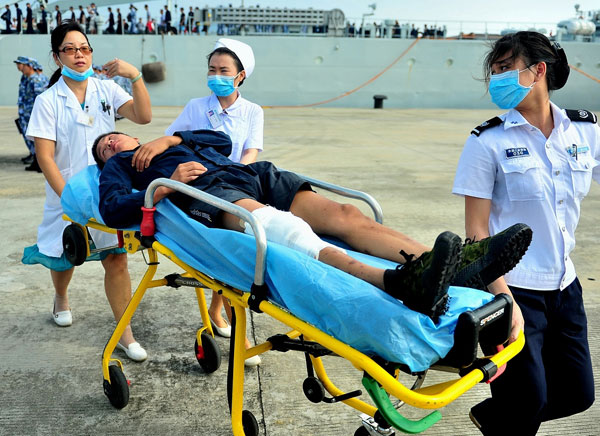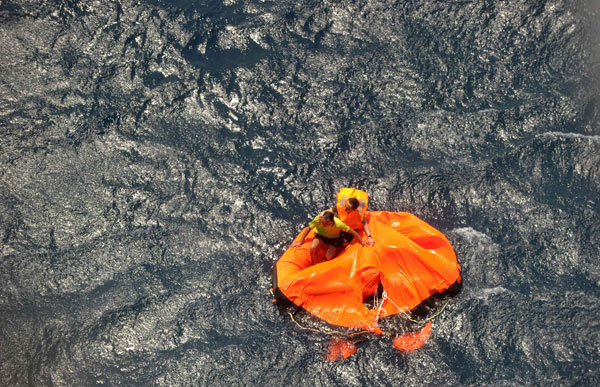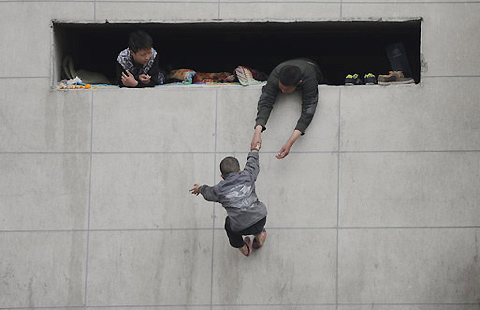Rallying to the rescue of fishermen
By Peng Yining in Hainan and He Na, Jiang Xueqing and Wu Wencong in Beijing ( China Daily ) Updated: 2013-10-11 07:41:45

Unprecedented efforts to save lives in the South China Sea, report Peng Yining in Hainan and He Na, Jiang Xueqing and Wu Wencong in Beijing.
Editor's note: On June 10, the Peace Ark embarked on a 118-day voyage to provide medical assistance in a number of countries and take part in joint operations and exercises with fellow members of ASEAN. This is the last report by China Daily's Peng Yining.
Lei Jie rappelled down a line from a helicopter to reach a fisherman who was floating in the ocean, but he was unable to get close enough.
The 34-year-old sailor later dropped into the water and tried to swim toward the man, but "I was trapped in the current," he said.
"I could see him a couple of meters away, wearing black rubber coveralls, floating face down and with his limbs splayed. I wanted to drag him to a life raft, but I couldn't get any closer."
The man was later pulled from the water by another Peace Ark rescue team, but he had died long before he was spotted.
On Sept 29, Typhoon Wutip hit the South China Sea, sinking three fishing boats from Guangdong province carrying 88 people. Fourteen fishermen are known to have died in the storm, 26 were rescued and 48 are still missing, according to the emergency command center of Hainan province.
As Wutip tore across southern China, President Xi Jinping ordered the governments of Hainan and Guangdong to make every effort to search for and rescue the stranded, limit injuries and help the relatives of the victims.
Premier Li Keqiang also instructed government departments to cooperate closely and ensure the safety of rescue workers.
By Sunday, the Hainan Maritime Safety Administration had coordinated 175 rescue ships and naval vessels and 47 aircraft to participate in the mission. Rescue workers searched for survivors across 136,100 square kilometers of ocean and 165,600 sq km of airspace.
The mission in the Xisha Islands was unprecedented in the South China Sea in terms of scale and the resources invested, said Xu Yun, deputy secretary-general of the Hainan provincial government. It not only demonstrated a people-oriented philosophy, but also showed that China's comprehensive national power has increased and its marine rescue operations are world class, he said.
In addition to sinking the three boats from Guangdong, Wutip also destroyed 33 fishing boats and a merchant ship from Hainan, sank four fishing boats and stranded 28 boats and ships. More than 520 people in immediate danger were quickly evacuated to Sanya city.
Xiao Changyi, a 46-year-old fisherman from Hainan, said he abandoned his trip as soon as the alarm was sounded. "It was a close call. The storm was tossing the boat around and the seas were extremely heavy," he said. "Fishing is dangerous work. I'm grateful that the government has paid such close attention to rescue work and our safety. It makes me feel safer and more confident at sea."
Chen Seyan, a 53-year-old fisherman who was pulled from the water told China Communications News: "Suddenly my mind went blank when I fell from the boat. I thought my life was definitely over. I came round after a while and found I was floating on the surface of the water, clinging onto a piece of the sampan, I knew someone would come to my aid and I want to thank the search and rescue staff that gave me a new life," he said.
Some rescued fishermen displayed placards at Sanya port reading: "Thank you! The army made up of the sons of the People. Thanks for your hard work!"
|
|
|
|
|
|
|
|




















 Op Rana
Op Rana Berlin Fang
Berlin Fang Zhu Yuan
Zhu Yuan Huang Xiangyang
Huang Xiangyang Chen Weihua
Chen Weihua Liu Shinan
Liu Shinan